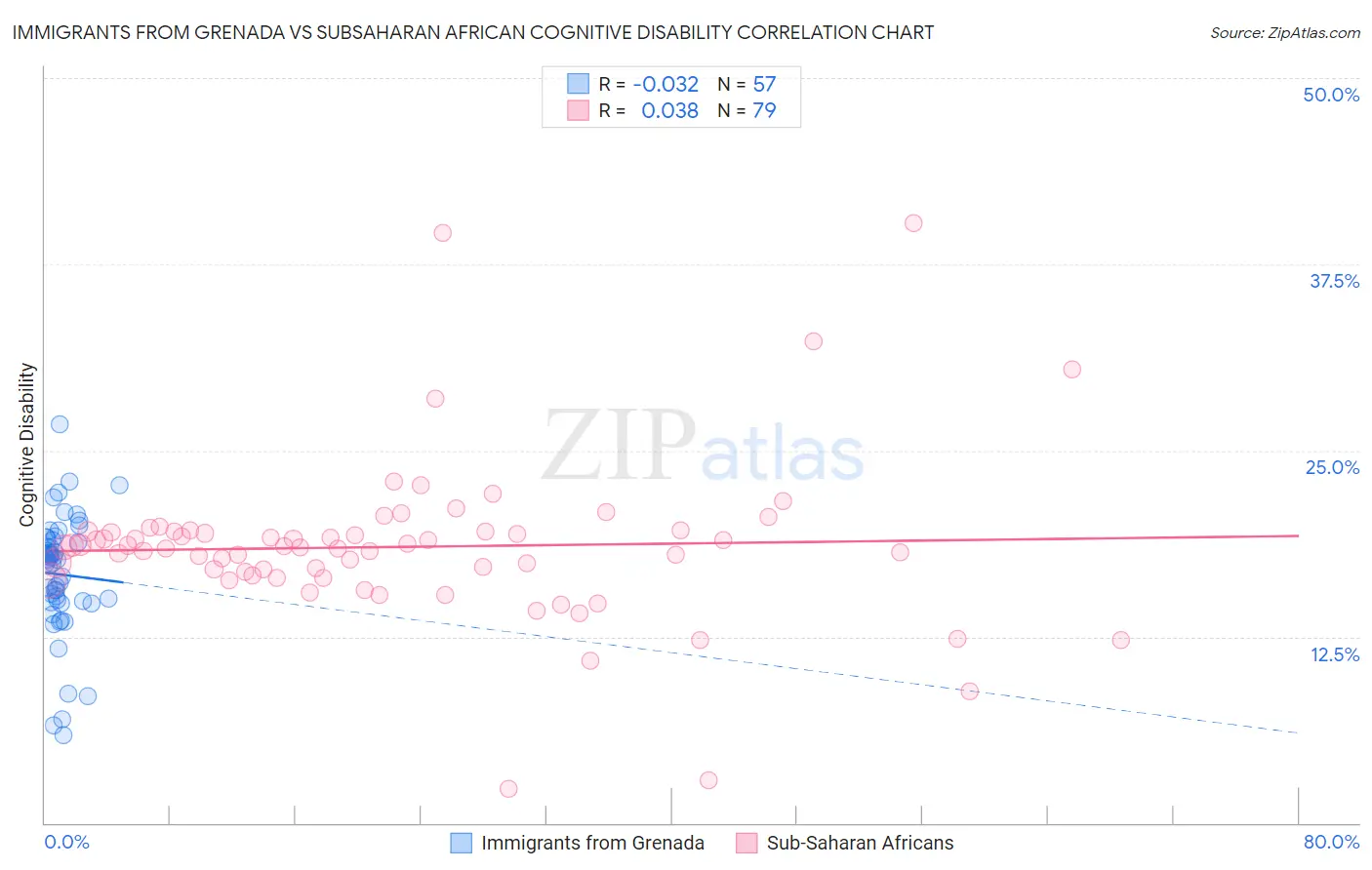Immigrants from Grenada vs Subsaharan African Cognitive Disability
COMPARE
Immigrants from Grenada
Subsaharan African
Cognitive Disability
Cognitive Disability Comparison
Immigrants from Grenada
Sub-Saharan Africans
17.9%
COGNITIVE DISABILITY
0.6/ 100
METRIC RATING
252nd/ 347
METRIC RANK
18.5%
COGNITIVE DISABILITY
0.0/ 100
METRIC RATING
314th/ 347
METRIC RANK
Immigrants from Grenada vs Subsaharan African Cognitive Disability Correlation Chart
The statistical analysis conducted on geographies consisting of 67,189,782 people shows no correlation between the proportion of Immigrants from Grenada and percentage of population with cognitive disability in the United States with a correlation coefficient (R) of -0.032 and weighted average of 17.9%. Similarly, the statistical analysis conducted on geographies consisting of 508,099,215 people shows no correlation between the proportion of Sub-Saharan Africans and percentage of population with cognitive disability in the United States with a correlation coefficient (R) of 0.038 and weighted average of 18.5%, a difference of 3.5%.

Cognitive Disability Correlation Summary
| Measurement | Immigrants from Grenada | Subsaharan African |
| Minimum | 5.9% | 2.3% |
| Maximum | 26.8% | 40.3% |
| Range | 20.9% | 38.0% |
| Mean | 16.7% | 18.5% |
| Median | 17.7% | 18.5% |
| Interquartile 25% (IQ1) | 14.8% | 16.6% |
| Interquartile 75% (IQ3) | 19.0% | 19.6% |
| Interquartile Range (IQR) | 4.2% | 2.9% |
| Standard Deviation (Sample) | 4.0% | 5.5% |
| Standard Deviation (Population) | 4.0% | 5.5% |
Similar Demographics by Cognitive Disability
Demographics Similar to Immigrants from Grenada by Cognitive Disability
In terms of cognitive disability, the demographic groups most similar to Immigrants from Grenada are Malaysian (17.9%, a difference of 0.010%), Hopi (17.9%, a difference of 0.010%), Cree (17.9%, a difference of 0.020%), Immigrants from Ethiopia (17.9%, a difference of 0.020%), and Hispanic or Latino (17.9%, a difference of 0.020%).
| Demographics | Rating | Rank | Cognitive Disability |
| Trinidadians and Tobagonians | 0.8 /100 | #245 | Tragic 17.9% |
| Immigrants | Thailand | 0.8 /100 | #246 | Tragic 17.9% |
| Samoans | 0.7 /100 | #247 | Tragic 17.9% |
| French American Indians | 0.7 /100 | #248 | Tragic 17.9% |
| Cree | 0.7 /100 | #249 | Tragic 17.9% |
| Immigrants | Ethiopia | 0.7 /100 | #250 | Tragic 17.9% |
| Malaysians | 0.6 /100 | #251 | Tragic 17.9% |
| Immigrants | Grenada | 0.6 /100 | #252 | Tragic 17.9% |
| Hopi | 0.6 /100 | #253 | Tragic 17.9% |
| Hispanics or Latinos | 0.6 /100 | #254 | Tragic 17.9% |
| Immigrants | Azores | 0.6 /100 | #255 | Tragic 17.9% |
| Bahamians | 0.6 /100 | #256 | Tragic 17.9% |
| Mexican American Indians | 0.6 /100 | #257 | Tragic 17.9% |
| Immigrants | Armenia | 0.6 /100 | #258 | Tragic 17.9% |
| Ethiopians | 0.5 /100 | #259 | Tragic 17.9% |
Demographics Similar to Sub-Saharan Africans by Cognitive Disability
In terms of cognitive disability, the demographic groups most similar to Sub-Saharan Africans are Yaqui (18.5%, a difference of 0.060%), Chickasaw (18.5%, a difference of 0.17%), Immigrants from Dominica (18.6%, a difference of 0.18%), Immigrants from Middle Africa (18.6%, a difference of 0.26%), and Liberian (18.6%, a difference of 0.34%).
| Demographics | Rating | Rank | Cognitive Disability |
| Ugandans | 0.0 /100 | #307 | Tragic 18.3% |
| Immigrants | Western Africa | 0.0 /100 | #308 | Tragic 18.4% |
| Immigrants | Eastern Africa | 0.0 /100 | #309 | Tragic 18.4% |
| Choctaw | 0.0 /100 | #310 | Tragic 18.4% |
| Hmong | 0.0 /100 | #311 | Tragic 18.4% |
| Chickasaw | 0.0 /100 | #312 | Tragic 18.5% |
| Yaqui | 0.0 /100 | #313 | Tragic 18.5% |
| Sub-Saharan Africans | 0.0 /100 | #314 | Tragic 18.5% |
| Immigrants | Dominica | 0.0 /100 | #315 | Tragic 18.6% |
| Immigrants | Middle Africa | 0.0 /100 | #316 | Tragic 18.6% |
| Liberians | 0.0 /100 | #317 | Tragic 18.6% |
| Bangladeshis | 0.0 /100 | #318 | Tragic 18.6% |
| Comanche | 0.0 /100 | #319 | Tragic 18.6% |
| Apache | 0.0 /100 | #320 | Tragic 18.6% |
| Africans | 0.0 /100 | #321 | Tragic 18.6% |